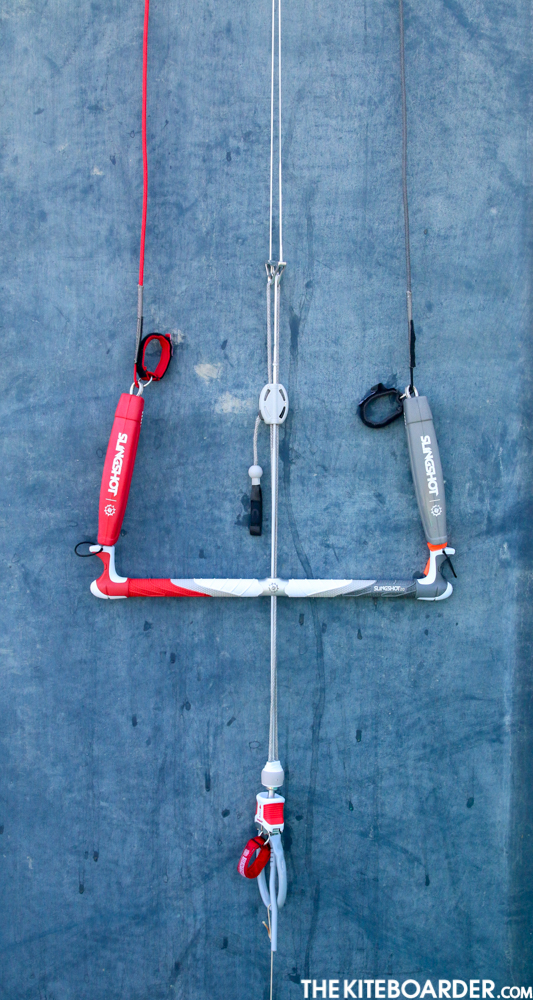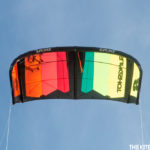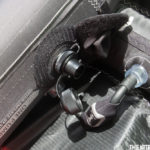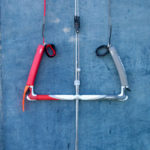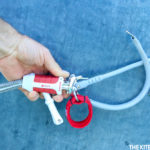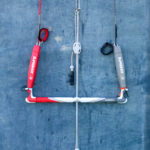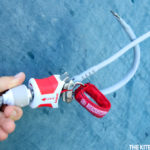Sizes Available: 4.5, 6, 7, 8, 9, 10, 11, 12, 14m
Sizes Tested: 8, 10, 12m
Slingshot Says:
For years, the RPM was fine-tuned to load, pop and go slack in the air before re-engaging. We had the tuning down to a science, and it helped give multiple freestyle world champions their gold medals. Our mission with the 2019 RPM was to change that ”” not to eliminate anything ”” but to shift the kite’s tuning to where we see the sport shifting. At the level the RPM is designed for that means bigger, better, loftier in-air performance. From slack to soar, the 2019 RPM is the world’s go-to kite for versatile freeride performance.
New Modified Open-C: We decreased the open-C arc of the RPM in favor of a fuller and deeper C. This is a significant change to the kite, on the beach it will look about the same, but in the air, anyone who knows the RPM will see and feel the difference right away. This difference in shape has a big impact on performance – most notably in overall power, structural stability, hangtime, and control in the air.
New Flyline Bridle: A combination of the pulleyed bridle featured on previous RPM models and the bungee IRS bridle we engineered a few years ago. We introduced pulleys on the RPM to give the kite more structural stability and dynamic steering. Then we replaced the pulleys with our IRS bungee system to achieve a more direct feel and smoother power delivery as the kite flies through the window. The FLYLINE bridle combines both pulley and bungee in a new configuration that results in a faster, higher-flying, more powerful RPM than ever before.
NEW LoadShift: The new configuration of the FlyLine bridle and the location of the pulley and bungee segments give the 2019 RPM a dynamic steering behavior unlike any other kite we’ve made. In what is best described as ”˜Load Shift’ the FlyLine bridle transfers power and load actively from wingtip-to-wingtip as it flies. Where other kites would warp or twist under load, buckle at the wingtips, flutter or stall out in the air, the new RPM shifts and distributes load actively throughout the canopy, resulting in smoother, cleaner, more powerful performance. World-class unhooked performance- the kite of choice for Carlos Mario, if that name rings a bell. Hybrid Open-C shape delivers big boosts and smooth, predictable loops.
Visit for more info: www.slingshotsports.com/2019-RPM
Our Testers Say:
“Strong, solid feel, super stable, medium plus bar pressure, good upwind ability, turns great in the larger sizes, great boost, good hangtime. If you know how to use it this kite will rock!” // Kiter Mike
“New bridle system stays true to the RPM feel. Turn and response is better this year with a very direct feel that lets you know where the kite is at all times.” // Dylan Dobbyn
“Steady consistent pull, solid construction, super stable with very reactive steering. Instantly felt comfortable on this kite, being both stable and reactive.” // Joe Chehock


TKB Says:
The Slingshot RPM is back for another year with a fairly giant shift in its targeted type of riding from years past. The RPM continues with its 3-strut medium aspect shape and C-style full canopy all the way into the squared wingtips but Slingshot has modified the canopy shape as well as the front bridles to shift the RPM away from load and slack wakestyle performance towards performance freeride big air and kiteloops. The RPM uses a large diameter bayonet style inflation valve that requires no nozzle on the end of your standard pump hose for a quick and easy pump up. When it comes time to deflate, there’s a standard dump valve that allows you to quickly deflate without opening the bayonet valve. The RPM features a new front bridle that offers two attachment settings and utilizes a single pulley as well as some extra load shifting lines to change the overall angle of attack. We tested the kite in the ”˜Freeride’ stock setting which is the forward setting on the LE that gives the kite the kite a little more depower, forward flying which Slingshot says is better for freeriding and big air. The aft setting is designated for wakestyle with the kite sitting deeper in the window and is less responsive. Historically, the RPM is one of those kites that offered load and slack wakestyle performance balanced with a good dose of softer freeride characteristics, yet this year Slingshot has adapted the normal RPM feel to accentuate the big air boosting and kitelooping performance that the majority of its freerider base prefers. Wakestyle purists will always have the Fuel and for those that want a hybrid, the RPM can still be tuned to its wakestyle setting. While the difference may visually seem subtle it felt like the RPM flew a little bit farther forward in the window and felt more user-friendly for loading up sent jumps for a solid amount of lift. Testers found the bar pressure to be medium with a fairly progressive power delivery. With the new changes the RPM still isn’t quite the sheet and go kite style kite you find in the Rally, instead the RPM continues to want to be flown aggressively to build power, yet the upside is more lift and bigger loftier airs. The RPM continues to be stable, yet it clearly wants to fly farther forward in the window and generate good pull and lift with each gust. The RPM seems to have a slightly tighter steering arc, not as tight as the Rally or the SST, but the steering response continues to feel direct and snappy with fairly swift turning speed. The RPM has a reliable relaunch from nose down in the bottom of the window; it required an extra tug on the floats to get the kite to rotate onto a wingtip, but when it flipped the wingtip cleared the water quickly and the kite launched back into the air fairly deep in the window, making for a reliable launch. Inevitably, the tweaks made to the RPM place it a little deeper in the performance freeride category along with the Rally, with the RPM coming from the C-Shape pedigree. The two kites couldn’t be more different, but they both excel in big air, with the RPM offering a bit more user-friendly handling along with improved big air lift and committed powered kiteloops. The question will be whether the smaller segment of wakestyle-oriented RPM riders will notice the difference in the pop and slack department. We think the RPM’s repositioning is a better mix of qualities that will make this kite more appealing to the larger segment of freeride kiters.
Our Slingshot kites came with both the Compstick Guardian or Compstick Sentinel control bars. Both of these bars are fixed length bars that comes in three sizes: 17” width with 20m lines, a 20” width with 23m lines (3m ext), and a 23” width with 27m lines.
The Compstick Sentinel features above the bar power tuning with single center-line safety depower, spectra sheeting/throw line with sliding stopper, adjustable length throw, tuning cleat power system with a toggle that uses a magnet to control excess tuning slack and a low V. The inside lines end in knots and the outside lines end in loops. The Sentinel offers a sturdy quick release that integrates a below the bar hand swivel which also doubles as a quick release guard. The quick release handle locks in the open position and resetting is fairly straight forward simply place the end of the loop back into position and then depress a stainless steel tab that frees the release handle and locks the quick release back together. Testers did note that when you release the gate, there is a sharp edge on the handle that tends to pinch the finger on the tab. This could be easily fixed by sanding off the pointy ends on the red and white handle. The Compstick is the only bar in our test that featured dual outside line OS handles with no adjustment for outside line length. OS handles can be bulky and a point of tangle in spaghetti situations, but they can also save you in a dicey situation. The bar ends offer bungees for keeping the lines clean and the floats are separate from the bar ends. While testers liked the smaller diameter grip and raised volcano next to the insert which helps avoid pinched fingers. Testers found the grip to be fairly dense with thin rubber ridges along the handle that make for a very aggressive yet solid grip. This year the bar got a color upgrade with the left side of the bar and the floats sporting a solid red color for a very clear and obvious color coding that is unmistakable. The Compstick features bomber construction and tons of features which makes this one of the heavier bars in our test and as a result comes with bulkier foam floats.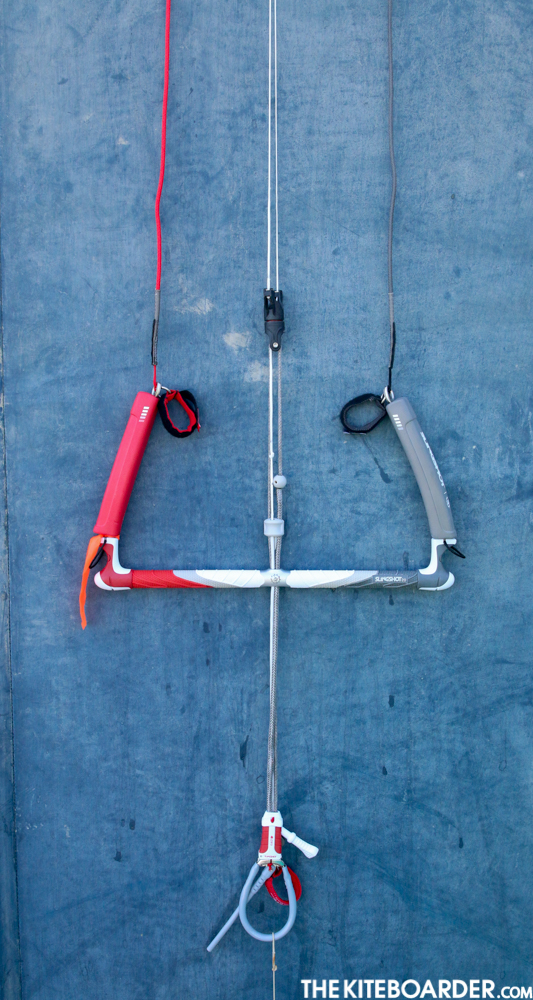 The Compstick Guardian features a single center-line safety depower, spectra sheeting/throw line, a low V, a sliding stopper andbelow the bar cleat tuning integrated into the push away quick release. There’s no travel guard or below the bar hand swivel but the quick release is compact and keeps a large amount of throw travel within reach of the rider. This bar uses Slingshot’s existing Guardian quick release system which puts the kite’s tuning below the bar, which allows surfers to increase the amount of throw/sheeting while still being able to reach the tuning of the kite. Testers who are not used to below the bar sheeting often find it’s difficult to get the leverage to operate the cleat, but with the proper technique (place the cleat on the side of your favored arm and sheet out while adjusting) this is a fairly easy and functional design for performance kiters. The bar design and other rigging is the same as the Compstick Sentinel (see above). If the advantages of below the bar tuning systems is lost on you, then check out the Compstick Sentinel above.
The Compstick Guardian features a single center-line safety depower, spectra sheeting/throw line, a low V, a sliding stopper andbelow the bar cleat tuning integrated into the push away quick release. There’s no travel guard or below the bar hand swivel but the quick release is compact and keeps a large amount of throw travel within reach of the rider. This bar uses Slingshot’s existing Guardian quick release system which puts the kite’s tuning below the bar, which allows surfers to increase the amount of throw/sheeting while still being able to reach the tuning of the kite. Testers who are not used to below the bar sheeting often find it’s difficult to get the leverage to operate the cleat, but with the proper technique (place the cleat on the side of your favored arm and sheet out while adjusting) this is a fairly easy and functional design for performance kiters. The bar design and other rigging is the same as the Compstick Sentinel (see above). If the advantages of below the bar tuning systems is lost on you, then check out the Compstick Sentinel above.
Visit for more info on the bar: www.slingshotsports.com/2019-Compstick-w-Guardian
With the help of 14 testers from all walks of kiteboarding, Tkb’s staff assembled detailed gear reviews with objective performance criteria of the latest 2019 kites, twin tips and foilboards all packed into one neat and tidy 180-page digital package. Get all the reviews in convenient digital guide here: https://www.thekiteboarder.com/product/2019-freeride-gear-review-guide/



